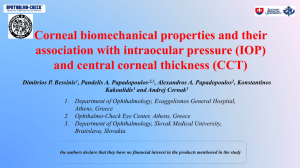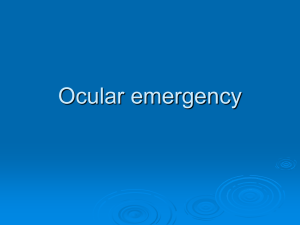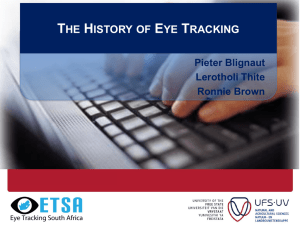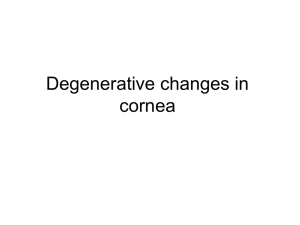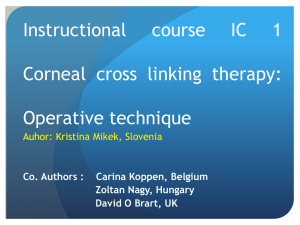Understand the Cornea Understand the Pressure
advertisement
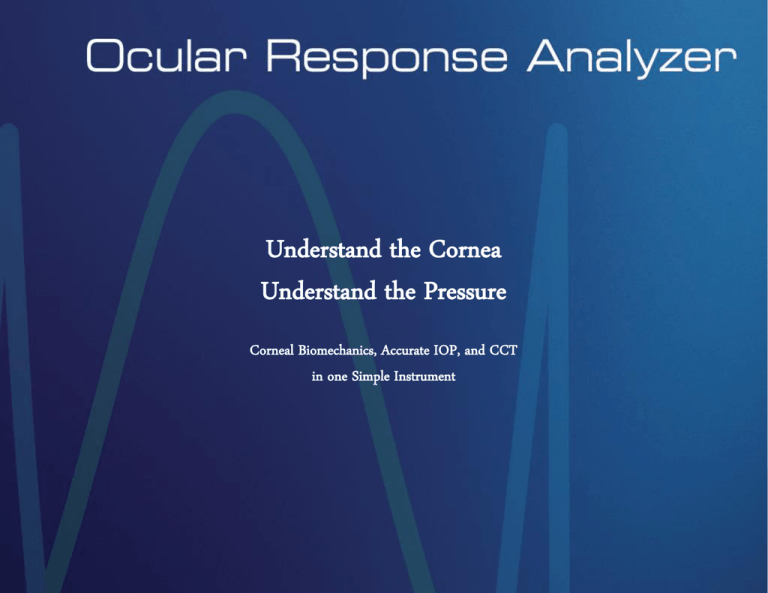
Understand the Cornea Understand the Pressure Corneal Biomechanics, Accurate IOP, and CCT in one Simple Instrument One Device, Five Parameters •IOPG - Goldmann Correlated IOP •IOPCC - Corneal Compensated IOP •CH - Corneal Hysteresis •CRF - Corneal Resistance Factor •CCT - Central Corneal Thickness ORA Technology Background Measuring “Pressure” Goldmann Tonometry Principles The Goldmann Tonometer has long been considered the gold standard for measuring pressure. It is based upon the Imbert-Fick Law (W = P x A) where: - W is the force to applanate - P is Intra Ocular Pressure (IOP) - A is the area applanated Measuring “Pressure” Goldmann Tonometry Assumptions - Surface is dry Volume is perfectly spherical Surface is infinitely thin and perfectly flexible Tear-film effect and corneal thickness effect cancel each other out Recognizing that corneal effects and surface tension are factors which influence the measurement; Goldmann selected a tonometer tip size of 3.06mm which he believed would nullify these effects based on a constant central corneal thickness of 525 microns Measuring “Pressure” Goldmann Tonometry Flaws - Experimentation done on cadaver eyes - Not representative of live corneas - Variation in corneal thickness is significantly greater than assumed - Variations in corneal biomechanical properties unaccounted for Accordingly, Goldmann tonometry cannot compensate for differences in corneal thickness, corneal elasticity, and many other parameters that influence tonometer readings. This applies to all other Goldmann-correlated tonometers! Non- Contact Tonometers - Invented by Dr. Bernie Grolman in the 1960’s (American Optical) - To enable OD’s in the USA to perform tonometry - Introduced in 1971 - Uses rapid air pulse technology - Easy to use - Strong Goldmann correlation - Objective: no operator bias - No anesthetic required - No risk of cross-contamination Modern NCT - AT555 NCT Traditional Method of Operation Traditional NCT vs. GAT “In conclusion, the current study shows that the XPERT vs GAT Sdiff (1.5 mmHg) is comparable to single GAT instrument repeatability, and far superior to that of two GAT instrument repeatability/reliability.” Ocular Response Analyzer Method of Operation Static vs. Dynamic Measurement Goldmann tonometers make ‘static’ measurements. That is they derive IOP from the force measured during a steady state applanation of the cornea. The Ocular Response Analyzer makes a ‘dynamic’ measurement, monitoring the movement of the cornea in response to a rapid air impulse. The ‘dynamic’ nature of the ORA measurement makes possible the capture of other useful data about the eye. Visco-Elastic System An Automotive “Strut” Assembly - Coil Spring: Static Resistance (Elasticity). strain (deformation) is directly proportional to stress (applied force), independent of the length of time or the rate at which the force is applied. - Shock Absorber: Viscous Resistance (Damping). The resistance to an applied force depends primarily on the speed at which the force is applied. Method of Operation Applanation Signal Plot Definitions Hysteresis The phenomenon was identified, and the term coined, by Sir James Alfred Ewing in 1890. Hysteresis is a property of physical systems that do not instantly follow the forces applied to them, but react slowly, or do not return completely to their original state. Corneal Hysteresis The difference in the inward and outward pressure values obtained during the dynamic bi-directional applanation process employed in the Ocular Response Analyzer, as a result of viscous damping in the cornea. Corneal Hysteresis: A New Ocular Parameter Right/Left Eye Hysteresis 18.00 2 R = 0.6625 16.00 14.00 12.00 10.00 8.00 6.00 4.00 2.00 0.00 0.00 5.00 10.00 15.00 20.00 Hysteresis vs. Corneal Radius 12.0 10.0 Hysteresis - mmHg R = 0.01 8.0 6.0 4.0 2.0 0.0 7 7.2 7.4 7.6 7.8 Average Corneal Radius - mm 8 8.2 8.4 Hysteresis vs. Corneal Astigmatism 12.0 Hysteresis - mmHg 10.0 R = 0.26 8.0 6.0 4.0 2.0 0.0 0 0.5 1 1.5 2 Corneal Astigmatism - D 2.5 3 CCT vs. CH - 184 normal eyes Data courtesy Mitsugu Shimmyo, MD IOPG vs CH - 339 Normal Eyes Data courtesy New England College of Optometry In/Out Applanation Regressions 32 eyes - 3 pressure levels (ODM induced) Conclusion: Hysteresis stays constant over a wide range of pressures for the same eyes ORA and Corneal Specialties Corneal Biomechanics: A New Area of Clinical Interest Ocular Response Analyzer is the only instrument capable of measuring the biomechanical properties of the cornea. Clinical data has shown that the Corneal Hysteresis measurement is useful in identifying corneal pathologies and may be valuable in identifying potential LASIK candidates who are at risk of developing ectasia. In consequence, the instrument is attracting interest from corneal specialists and refractive surgeons. Corneal Biomechanics and Refractive Surgery “Refractive surgery is not an exact science. Achieving the cornea’s ultimate shape depends on our ability to predict the biomechanical response to surgery.” Cynthia Roberts, Ph.D. Associate Professor of Ophthalmology and Biomechanical Engineering, OSU “The promise of wavefront-guided laser ablation will not be fully realized until researchers gain a more complete understanding of corneal biomechanics.” John Marshall, Ph.D. “Father of the Excimer Laser” “Wavefront by itself is a great tool but we still need to understand corneal biomechanics to reap the whole benefit.” David Williams, Ph.D. Direct of The Center For Visual Science, University of Rochester Classifying Corneal Pathologies Data courtesy Shah, Brandt, Pepose, Castellano Classifying Corneal Pathologies To investigate the biomechanical characteristics of eyes with: - Fuchs’ Corneal Dystrophy (n=14) - Post-Penetrating Keratoplasty (18±10 months postop, n=32) - Corneal Ectasia (n=46) - Advanced Keratoconus (CCT < 490 µm, n=15) - Pellucid Marginalis (n=4) - Early or Forme Fruste Keratoconus (CCT > 490 µm, n=27) - Compared to 3 pachymetry matched control groups Group 1: > 580 µm (n=31) Group 2: between 510 and 580 µm (n=66) Group 3: < 510 µm (n=17) To compare IOP measurements using 3 testing techniques GAT; NCT with ORA; Data courtesy Jay Pepose, MD - ASCRS 2006 PDCT Classifying Corneal Pathologies Control Group Differences Controls N CCT µm GAT mmHg ORA-g mmHg ORA-cc mmHg PDCT mmHg CH mmHg CRF mmHg OPA mmHg Group 1 17 603.7 ± 20.0 15.3 ± 2.3 17.6 ± 3.7 15.5 ± 3.5 17.8 ± 2.3 11.5 ± 1.8 11.8 ± 1.8 2.3 ± 1.1 Group 2 66 543.9 ± 18.3 14.5 ± 3.2 15.3 ± 3.1 15.5 ± 3.2 17.5 ± 3.3 9.7 ± 1.4 9.5 ± 1.3 2.3 ± 0.8 Group 3 31 487.9 ± 20.0 12.8 ± 2.7 13.2 ± 3.5 15.0 ± 3.0 16.6 ± 2.7 8.4 ± 1.2 7.8 ± 1.5 2.2 ± 0.9 = p<0.05 comparing Group 1 or 3 to Group 2, with Student’s t-test Data courtesy Jay Pepose, MD - ASCRS 2006 Classifying Corneal Pathologies Biomechanical Metrics in 3 Control Groups 12 mm Hg 10 8 6 4 2 0 CH Gro up 1(mean 603.8 µm) Data courtesy Jay Pepose, MD - ASCRS 2006 CRF Gro up 2 (mean 543.9 µm) OP Gro up 3 (mean 487.9 µm) Classifying Corneal Pathologies N Fuchs’ Group 1 14 17 KCN/ PKP Group 2 advanced PMD/ FFKCN 32 66 15 46 KCN Group 3 31 CCT 585.3 ± 603.7 ± 533.0 ± 543.9 ± 400.9 ± 462.6 ± 487.9 ± µm 52.5 20.0 72.2 77.4 20.0 47.1 18.3 ± 9.7 ± 7.0 ± 11.5 ± 9.2 ± 8.1 ± 8.4 ± 2.0 1.8 1.4 1.7 1.2 1.7 1.4 ± 9.5 ± 5.6 8.0 ± 11.8 ± 9.2 ± 7.0 ± 7.8 ± CRF 2.0 1.8 1.5 1.8 1.5 2.1 1.3 ± 2.0 2.3 ± 2.3 ± 2.6 ± 2.3 ± 2.2 ± 2.2 ± OPA 1.0 1.1 0.9 0.7 0.9 1.2 0.8 CH 8.0 = p<0.05 comparing study group to its respective control group, with Student’s t-test Data courtesy Jay Pepose, MD - ASCRS 2006 Classifying Corneal Pathologies Thin Cornea with no ectasia CH=11.2 CRF=10.8 Data courtesy Renato Ambrosio, MD - ASCRS 2006 Thin Cornea with Keratoconus CH=8.1 CRF=7.9 Classifying Corneal Pathologies CCT = 605 um; CH = 8.4mmHg; CRF = 8.0mmHg 3+ Corneal Gutata (Fuchs’Dystrophy) NORMAL CCT = 597 um; CH = 11.9mmHg; CRF = 11.4mmHg Data courtesy Renato Ambrosio, MD - ASCRS 2006 Pre / Post Lasik This patients pre-lasik CH is lower than the population average post-lasik CH. This patient may be a candidate for ectasia! Data courtesy Dr. David Castellano, MD / Dr. Jay Pepose, MD Normal vs. Keratoconic Signals KERATOCONUS NORMAL Data courtesy Mr. Sunil Shah, MD Normal vs. Fuchs’ Signals FUCHS’ NORMAL Data courtesy Dr. James Brandt, MD Pre and Post Lasik Signals POST-LASIK PRE-LASIK Data courtesy Dr. David Castellano, MD Signals are “Corneal Signature” NORMAL FUCHS’ KERATOCONUS POST LASIK Predicting Ectasia Risk Data courtesy Peter Hersh ORA and Glaucoma Landmark Studies Many recent studies have concluded, for the first time, that controlling IOP in glaucoma patients and suspects stops or slows the progression of the disease. These studies include: - OHTS - Ocular Hypertension Treatment Study - AGIS - Advanced Glaucoma Intervention Study - CNTGS - Collaborative Normal-Tension Glaucoma Study - CIGTS - Collaborative Initial Glaucoma Treatment Study Many of these studies have also investigated the role of the cornea in the diagnosis and management of glaucoma. The cornea and glaucoma • Some studies have investigated Corneal thickness as a contaminating factor in measuring IOP • Others have investigated Corneal thickness as an independent indicator of glaucoma risk - Could a thin cornea be a surrogate for eyes susceptible to glaucoma damage? Central Corneal Thickness Recently a great deal of attention has been focused on the relationship between central corneal thickness (CCT) and Goldmann-obtained IOP values. Studies have found that corneal thickness influences the accuracy of IOP measurements. - Thicker corneas, on average, tend to overstate GAT IOP values - Thinner corneas, on average, tend to understate GAT IOP values HOWEVER, this is only true ON AVERAGE for large populations - The IOP/CCT relationship is actually quite weak and varies from study to study, making correcting IOP based on CCT impractical The problem with CCT 184 Normal Eyes Data courtesy New England Collage of Optometry The problem with CCT • • • • • Two corneas, both 0.65 mm One is clear The other is edematous The first reads high (compared to manometry), the second low Thickness can’t be the whole answer • Other corneal factors besides thickness determine response of corneo-scleral shell to force – Hydration – Connective tissue composition – Bio-elasticity Data courtesy Harry Quigley, Wilmer Eye Institute The problem with CCT “We should not assume that corneal thickness is the parameter of greatest interest in monitoring glaucoma or in determining what features of the eye are important in optic nerve damage”. “Physiology is more important than anatomy” - Harry Quigley, Director of Glaucoma Service, Wilmer Eye Institute “Adjusting IOP by means of a fixed CCT algorithm is almost certainly wrong in the majority of our patients and is attempting to instill a degree of precision, into a relatively flawed instrument (the Goldmann tonometer), that simply is not there” - James Brandt, Director of Glaucoma Services, UC Davis CH distribution - Normals & Glaucoma Data courtesy New England College of Optometry and Mitsugu Shimmyo, MD Corneal Properties and Glaucoma Risk Additional Parameters: P1 and P2 provide independent information about the eye Background Background Data courtesy Dr. David Castellano, MD / Dr. Jay Pepose, MD Background Data courtesy Dr. David Castellano, MD / Dr. Jay Pepose, MD Gaining additional Useful Information •Clinical data analysis demonstrated that p1 and p2 respond independently to various factors (CCT, LASIK, IOP reduction, etc) •Therefore, an “optimum combination” of the two independent parameters may yield the best IOP and Corneal Parameter, resulting in: •Reduced or eliminated ORA IOP change after LASIK •Reduced or eliminated Corneal Parameter change after pressure reduction •Increased correlation of Corneal Parameter and CCT •Reduced or eliminated correlation of ORA IOP and CCT •Reduced or eliminated correlation of ORA IOP and Corneal Parameter •Reduced (slightly) correlation of ORA IOP and GAT •Higher correlation of Corneal Parameter with GAT than CCT with GAT •Reduced or eliminated anomalous low IOP for keratoconus, fuch’s patients IOPcc Corneal Compensated IOP Define & Describe IOPCC Corneal-Compensated Intraocular Pressure - An Intraocular Pressure measurement that is less affected by corneal properties than other methods of tonometery, such as Goldmann (GAT). IOPCC has essentially zero correlation with CCT in normal eyes and stays relatively constant post-LASIK. - Developed using clinical data and a proprietary algorithm. Method for finding “invariant” pressure • Use linear combination of P1 & P2 - avoids potential coupling of IOP & CH • Vary ratio of P1 & P2 to minimize difference of pre-post LASIK IOP •Upon achieving desired post-LASIK results, verify that: •Correlation with Goldmann is still strong •Correlation of IOP with CCT in various data sets is minimal •Correlation of IOP with CH in various data sets is minimal •Optimum formula: IOPcc = P2 - (0.43*P1) IOPG vs. CCT - 184 normal eyes Data courtesy New England Collage of Tonometry IOPCC vs CCT 184 Normals • Data courtesy New England Collage of Optometry IOPcc vs. GAT and DCT IOP Thin, Average, and Thick Cornea Groups 18 16 14 mm Hg 12 10 8 6 4 2 0 GAT ORA-g Gro up 1(mean 603.8 µm) Data courtesy Jay Pepose, MD - ASCRS 2006 ORA-cc Gro up 2 (mean 543.9 µm) PDCT Gro up 3 (mean 487.9 µm) 28 eyes Pre/Post LASIK IOPCC 26% IOP drop Data courtesy Dr. David Castellano, MD / Dr. Jay Pepose, MD 3% IOP drop 24 “NTG” eyes IOPCC is higher than traditional IOP in “NTG” subjects Data courtesy Mitsugu Shimmyo, MD Is IOPcc Better than GAT? •IOPcc correlates strongly with GAT on the average •HOWEVER, IOPcc has the following advantages over GAT •Not affected by CCT •Not affected by corneal biomechanical properties (rigidity) •As such, it is more accurate in KC, Fuchs’, OHT, NTG eyes •In addition, it has less measured IOP reduction post-LASIK •No operator bias Is IOPcc Better than GAT? CRF Corneal Resistance Factor Define & Describe CRF Corneal Resistance Factor An indicator of the overall “resistance” of the cornea, including both the viscous and elastic properties. It is significantly correlated with Central Corneal Thickness (CCT) and GAT, as one might expect, but not with IOPCC. Method for finding “CRF” corneal resistance factor • Use linear combination of P1 & P2 - avoids potential coupling of IOP & CH • Vary ratio of P1 & P2 to: •Maximize correlation of CH and CCT in various populations •Minimize CH change after pressure reduction / increase •Maximize correlation of CH and GAT •Ensure CH remains significate indicator of corneal conditions such as Keratoconus, fuch’s, etc •Ensure significant CH change post-LASIK remains •Optimum corneal parameter: CRF = P1-(0.7*P2) Correlation of CRF and CCT Correlation of CH and CRF vs. CCT 339 Normal Eyes Correlation of CH & CRF vs. IOPG (“GAT”) CRF - Normals, Keratoconus, Fuchs’ CRF is a better indicator of KC than CH Data courtesy Shah, Brandt, Pepose, Castellano CRF distribution - Normals & Glaucoma Data courtesy New England College of Optometry and Mitsugu Shimmyo, MD How do CH and CRF Differ Correlation of CH, CRF & IOPg Data courtesy Dr. Mitsugu Shimmyo, MD IOPCC vs CRF 339 Normals • Are CH and CRF Related to the “Modulus of Elasticity”? NO! Researchers have attempted to identify the young's modulus of the cornea - but the reported values in the literature, vary by four orders of magnitude! The cornea is a system, not an isotropic material such as steel or rubber. Attempting to identify the youngs modulus is a gross oversimplification of a complex subject. Interpreting ORA Measurement Results Measurement Signal Components Applanation Events Raw Signal Filtered Signal Air Pulse P1 P2 Identifying Normal Signals “Rules of thumb” High Ave Low IOPg IOPcc CH CRF CCT X X X X X - Watch for: - Clean, smooth signals - Similar amplitude peaks - Repeatable values - Consistent measurements in both eyes Identifying Normal Signals IOPcc and IOPg are close and in normal range CH and CRF are close and in normal range Filtered peaks “line up” under raw peaks Similar signal amplitude Raw signal has clean points Raw signal is fairly smooth Baseline signal is “flat” and nearly same amplitude on both sides Identifying Normal Signals Identifying Normal Signals Identifying Normal Signals Identifying Keratoconus “Rules of thumb” High Ave Low IOPg IOPcc X X X CH CRF CCT X X X - Watch for: - Low amplitude peaks - less repeatable signals than normal subject - “noisy” signals - Often present in one eye and not the other. Identifying Keratoconus Signals IOPcc Higher than IOPG Low CH Low CRF Thin CCT Low amplitude peaks Sharp, thin peaks P2 raw signal “bounce” More “noisy” raw signal Noisy signals cause less repeatable values Identifying Keratoconus Signals Identifying Keratoconus Signals Questionable Keratoconus Signal Measurement may yield unreliable results Raw signal is too “lumpy” Identifying Severe Keratoconus “Rules of Thumb” IOPg High Ave Low IOPcc CH CRF ??????????? - Look at the signal, the numbers may be unreliable - Thin CCT - Very low amplitude peaks - practically a flat line - General signal shape is very repeatable - Often present in one eye and not the other CCT Severe Keratoconus Signal Measurement values will be unreliable CH and CRF are unreliable due to signal amplitude Forget about the CH, no question this Keratocouns!! Identifying Forme Fruste KC “Rules of Thumb” High Ave Low IOPg IOPcc X X X CH CRF CCT X X X - Watch for: - Rule out past history of refractive surgery - lower amplitude peaks - Rapid P2 raw signal falloff with small “ricochet bounce” - Suspicious topography - “noisy” signals, but cleaner than advanced KC and more repeatable - Family history, frequent eye-rubbing, trouble wearing contacts “Sub-Clinical” Keratoconus Signal Signal looks nearly normal but low CH and CRF IOPcc Higher than IOPG CH just below normal range CRF just below normal range Mild P2 raw signal “bounce” Identifying Refractive Surgey “Rules of Thumb” High Ave Low IOPg IOPcc X X X CH CRF CCT X X X - Watch for: - low amplitude peaks (cleaner in LASIK than PRK) - “Sharp / thin” raw signals (especially in LASIK) - Rapid P2 raw signal falloff with pronounced “ricochet bounce” - less repeatable signals than normal subject (Especially in PRK) - “noisy” signals (Especially in PRK) Pre / Post-LASIK Signals PRE-LASIK IOPg, IOPcc close and in normal range CH, CRF close and in normal range Normal Signal POST-LASIK IOPcc higher than IOPg, closer to normal CH, CRF low CCT lower Thin, sharp peaks Reduced signal amplitude Some “noise” P2 “bounce” Pre / Post-LASIK Signals PRE-LASIK POST-LASIK Pre / Post-LASIK Signals Example of less reliable, but still useful, signals PRE-LASIK CH, CRF may be higher in reality P1, not ideal POST-LASIK IOP probably higher in reality CH may be lower in reality But the CRF is reduced! Neither signal is “ideal” but the post-lasik difference is still clear. TAKE MULTIPLE READINGS!! P1, not ideal Pre / Post PRK Signals PRE-PRK 2 Months POST-PRK IOPg, IOPcc close and in normal range CH, CRF close and in normal range But CH, CRF stay low Signal improves with time Normal Signal CH, CRF reduced Note how well IOPcc works! 2 wks POST-PRK PRK signals are noisy Identifying Ectasia “Rules of Thumb” IOPg High Ave Low IOPcc CH CRF X X CCT X X X - Watch for: - Has had LASIK, PRK, other surface ablation procedure - Very low amplitude, noisy, “messy” signals - Signal quality does not improve over time - Suspicious topography - Often present in one eye and not the other Identifying Ectasia Signals IOPcc Higher than IOPG Low CH Low CRF Thin CCT Low amplitude peaks Lots of noise Sharp, thin peaks P2 raw signal “bounce” Identifying POAG “Rules of Thumb” High Ave Low IOPg X X IOPcc X X CH CRF CCT X X X X X X - Watch for: - IOPcc higher than IOPg - Noisy signals - Family history, race, age, CDR, Diabetes status, Visual fields results, optic nerve status Identifying POAG Signals Uncontrolled Subject, moderately high IOP Signals are high amplitude, noisy IOPg, IOPcc both elevated Low CH CRF higher than CH Identifying POAG Signals Subject on meds, but progressing IOP is in normal range but IOPcc Higher than IOPG Low CH Low CRF Signal is smoother than high IOP signals Identifying POAG Signals Subject on meds and stable IOP is well controlled CH, CRF in normal range Signal is smooth Identifying POAG Signals Uncontrolled Subject - Blind IOPg, IOPcc both elevated Low CH High CRF Signals are low amplitude, lumpy, and noisy Identifying OHT “Rules of Thumb” High Ave Low IOPg X IOPcc CH X CRF X CCT X X - Watch for: - IOPcc lower than IOPg - Smooth signal - Family history, race, age, CDR, Diabetes status, Visual fields results, optic nerve status Identifying OHT Signals Subject is a “false positive” IOPg much higher than IOPcc CH, CRF are very high Signal is smooth Rules-of-thumb Spotting NTG/LTG IOPg High Ave Low X X IOPcc X X CH CRF CCT X X X - Watch for: - IOPcc higher than IOPg, but may still be in “normal” range - Low amplitude signals, some noise - Family history, race, age, CDR, Diabetes status, Visual fields results, optic nerve status Identifying NTG Signals IOPcc Higher than IOPG Low CH Low CRF Low amplitude peaks Thin CCT Rules-of-thumb Spotting “unusual” eyes / corneas - Atypical measurement signals that are: - less repeatable than normal - highly variable numeric measurement values - Investigate previous ocular history for surgery, disease, trauma, etc - What to do: - take a series of measurement - look for the “best signals” possible - try to get two that look similar and yield similar results - delete clearly “bad” signals and use average values of good ones Unusual Signals “Bizarre” signals are often very repeatable Just the fact that they are “different” is telling us something about the cornea / eye
